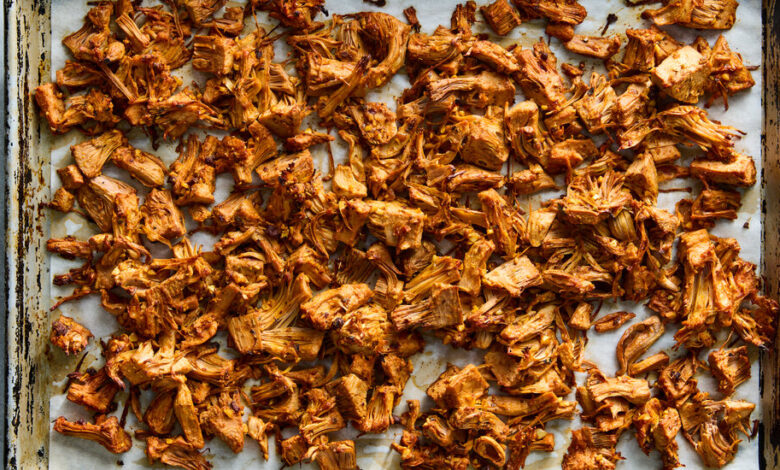A Vegan Pernil for the Holidays

In 2015, Norma Pérez adopted a vegan diet to combat her arthritis. But she worried that she’d miss out on the Salvadoran dishes she grew up with, particularly holiday dishes like her tamales and pan con pollo.
Then she remembered the many plant-based options in El Salvador. She just needed her sazón and other spices and herbs that her mother taught her to use when Ms. Perez was growing up in Los Angeles.
“Just because you go vegan doesn’t mean you’re going to lose your culture,” said Ms. Perez, who now lives in Ontario, Calif., and teaches people how to make vegan versions of their Salvadoran favorites on her website, the Salvi Vegan. Since changing her diet, Ms. Perez has made vegan versions of 68 Salvadoran dishes, including tamales with a filling of soy-based chicken or king oyster mushrooms.
Many Americans are vegetarian and vegan (Gallup recently estimated that about 4 percent identify as vegetarian and another 1 percent as vegan), and the holidays bring up various anxieties. They can be even more unnerving for vegan Latinos in the United States, where pernil or a whole slow-roasted hog could be at the center of the celebrations.
As a result, many are transforming their family recipes, traditionally made with meat or dairy, into vegan showstoppers so good that the abuelas and tias prefer the vegan adaptations.
Lyana Blount, the author of “Black Rican Vegan: Fire Plant-Based Recipes From a Bronx Kitchen,” and the owner of a soul food and Puerto Rican food pop-up of the same name, serves many customers who aren’t vegan but are curious about her food.
She recalled one customer who brought her vegan pernil — made with jackfruit to mimic the texture of shredded roast pork, and marinated with Puerto Rican sauces and spices — to their abuela, who said she couldn’t believe it was jackfruit.
“When I get that feedback, it makes me feel so good, and it gives me confirmation that what I’m doing is necessary,” said Ms. Blount, who became vegan in 2016 for health reasons. “It’s showing that they don’t have to consume meat all the time.”
Raul Medina, a chef in Oakland, Calif., said the key to his vegan tamales and pozole is his homemade vegan lard, which he makes with coconut oil and the rendered fat from his leftover vegan meat dishes, like his mushroom carnitas. He first cooks the spices and chiles in the melted fat, then adds the remaining ingredients so that the soup feels just as fatty as one made with pork.
“Pozole isn’t just a broth or a soup, it’s a thickness — a mouthfeel and greasiness that coats your tongue,” said Mr. Medina, whose abuela taught him cook at her ranch in Durango, Mexico. He will also open his first vegan restaurant, La Venganza, on Friday. “I will put it up against anybody’s pozole.”
When Sabrina Rodriguez, of Elmwood Park, N.J., first told her tia Aida Padilla that she was going to eat a vegan diet, Ms. Padilla offered to teach her how to make arroz con gandules without the addition of ham. She reassured her niece, “We’ll make some changes, and it’ll taste just as good.”
For Noche Buena celebrations, Ms. Rodriguez makes her aunt’s rice, as well as a vegan pastelón, a Puerto Rican lasagna made with sweet plantains, cheese and a soy meat alternative to mimic ground beef.
“I was always nervous that I was going to lose that part of my identity by making this decision,” said Ms. Rodriguez, who went vegan in 2017. “But I certainly don’t feel that way. I feel more closely connected to my culture than ever.”



